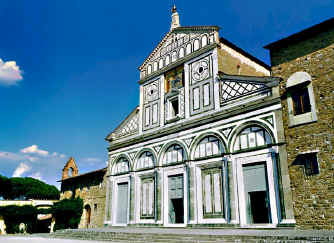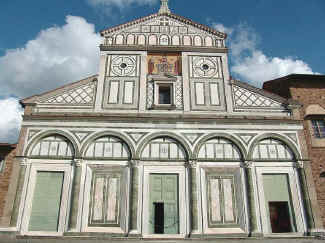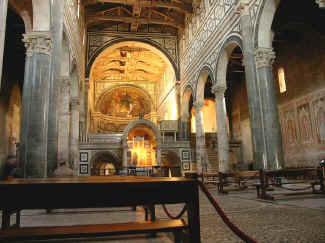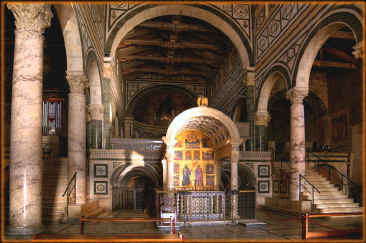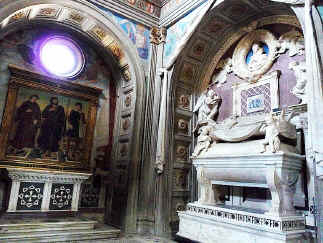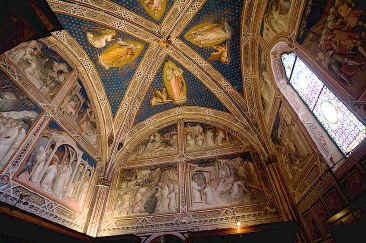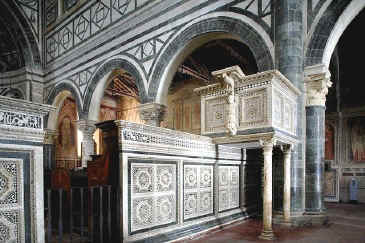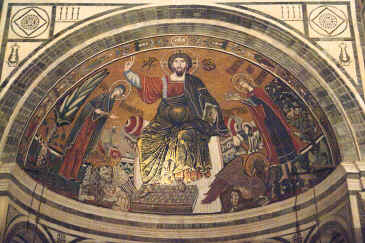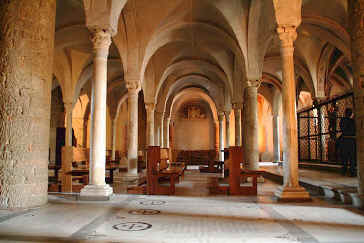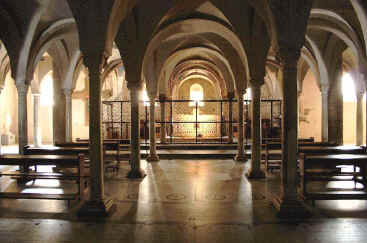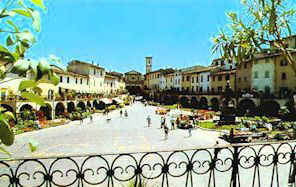|
The first order of the facade was initiated in 1070 and finished in the 13 C with the glowing colours of the mosaic of Christ enthroned between the Madonna and St. Miniato. However, the marble intarsia (white from Carrara and green from Prato), with its strict geometrical design, is the most important element of the facade. The architectural style derives from classical art via the Giotto's Baptistery. |
|||
|
> > > Click the pictures for a larger image < < <
The interior of the church of San Miniato al Monte |
|||
|
The naves The side (lateral) naves were finished in 1070. The last phase of construction was completed in 1207. The Basilica is divided into three naves without a transept: the exact proportions and the strict geometrical design as seen in the luminous and chromatic insertion of the mosaics derive directly from Classical and Byzantine Art. Columns with alternating polystyle pilasters divide the naves. The trussed ceiling of the middle nave was decorated in 1322. The present colours (red, white and green) owe their vividness to the restoration done in the style of the time (1860-1861). |
The Tabernacle The chapel commissioned by Piero di Cosimo de' Medici and attributed to Bernardo Rossellino (or perhaps Michelozzo as Varasi claims) was built to hold the Crucifix of St. John Gualberto. The two columns and the two half-pilasters each have capitals of a different order supporting a classical entablature. On this rests the elaborate barrelled vault in glazed blue and white terracotta. The external part of the tri-colored glazed tiled roof is by Luca della Robbia (1399/1400-1482). The panels on the altar begun by Agnolo Gaddi in 1394 and unfinished at the time of his death in 1396 represent Saint John Gualberto in an austere black monk's cloak and Saint Minias in colorful oriental attire. At the sides are scenes from the Passion of Christ; above, in the crown of the arch, is the Ascension flanked by the Annunciation, and in the predella, Mary and the twelve apostles. |
||
|
From the left nave there is access to the Chapel of the Cardinal of Portugal - one of the fjnest works of the Florentine Renaissance. It was begun immediately after the very young Cardinal's death in Florence on 27 August 1459. The initial design was by Antonio Manetti (Ciaccheri) but after his death in 1460 the work was continued by the "Alberti" workshop of Bernardo Rossellino. |
Entering the Sacristy one can follow the life of St. Benedict in the frescos commissioned by Benedetto degli Alberti, the first undertaking of the Olivetans who arrived at San Miniato in 1373. The entire decoration of the sacristy is attributed to Spinello Aretino (1387 -1388). The cycle of the scenes is illustrated in chronological sequence almost like a film. (Cf. the life of Saint Francis at Assisi by Giotto). The life of the saint is taken from "Dialogues" of Gregory the Great and from "Golden Legend" by Jacopo da Varagine. |
||
|
On the right of the presbytery is the ambo (pulpit) dated 1209. The lectern is supported by a "column" composed of a lion, a monk-telamon, and an eagle with outstretched wings. |
The mosaic in the bowl-shaped vault of the apse (ca.1260) portrays Christ the Pantocrator between Mary, St. Minias and the symbols of the four Evangelists. The figures stand out Byzantine-style against a gold background in a field populated with oriental birds (symbolizing souls). On the left, there is a date palm, symbol of Christ Resurrected. The phoenix on the right, spouting flames from its beak, and the peacock on the left are both symbols of the Resurrection of Christ. |
||
The Crypt of San Miniato al Monte |
|||
|
The austere crypt, finished about 1062, is divided into seven small aisles by thirty-eight slender columns |
|||
